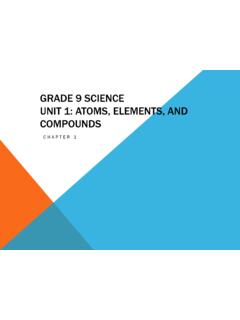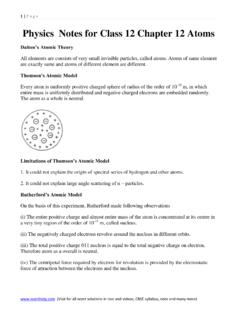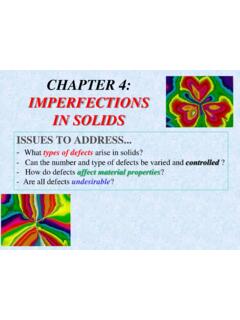Transcription of Chapter Twelve ATOMS
1 INTRODUCTIONBy the nineteenth century, enough evidence had accumulated in favour ofatomic hypothesis of matter. In 1897, the experiments on electric dischargethrough gases carried out by the English physicist J. J. Thomson (1856 1940) revealed that ATOMS of different elements contain negatively chargedconstituents (electrons) that are identical for all ATOMS . However, ATOMS on awhole are electrically neutral. Therefore, an atom must also contain somepositive charge to neutralise the negative charge of the electrons. But whatis the arrangement of the positive charge and the electrons inside the atom?In other words, what is the structure of an atom?The first model of atom was proposed by J.
2 J. Thomson in to this model, the positive charge of the atom is uniformlydistributed throughout the volume of the atom and the negatively chargedelectrons are embedded in it like seeds in a watermelon. This model waspicturesquely called plum pudding model of the atom. Howeversubsequent studies on ATOMS , as described in this Chapter , showed thatthe distribution of the electrons and positive charges are very differentfrom that proposed in this know that condensed matter (solids and liquids) and dense gases atall temperatures emit electromagnetic radiation in which a continuousdistribution of several wavelengths is present, though with differentintensities.
3 This radiation is considered to be due to oscillations of atomsChapter TwelveATOMS415 Atomsand molecules, governed by the interaction of each atom ormolecule with its neighbours. In contrast, light emitted fromrarefied gases heated in a flame, or excited electrically in aglow tube such as the familiar neon sign or mercury vapourlight has only certain discrete wavelengths. The spectrumappears as a series of bright lines. In such gases, theaverage spacing between ATOMS is large. Hence, theradiation emitted can be considered due to individual atomsrather than because of interactions between ATOMS the early nineteenth century it was also establishedthat each element is associated with a characteristicspectrum of radiation, for example, hydrogen always givesa set of lines with fixed relative position between the fact suggested an intimate relationship between theinternal structure of an atom and the spectrum ofradiation emitted by it.
4 In 1885, Johann Jakob Balmer(1825 1898) obtained a simple empirical formula whichgave the wavelengths of a group of lines emitted by atomichydrogen. Since hydrogen is simplest of the elementsknown, we shall consider its spectrum in detail in Rutherford (1871 1937), a former researchstudent of J. J. Thomson, was engaged in experiments on -particles emitted by some radioactive elements . In 1906,he proposed a classic experiment of scattering of these -particles by ATOMS to investigate the atomic experiment was later performed around 1911 by HansGeiger (1882 1945) and Ernst Marsden (1889 1970, whowas 20 year-old student and had not yet earned hisbachelor s degree).
5 The details are discussed in The explanation of the results led to the birth ofRutherford s planetary model of atom (also called thenuclear model of the atom). According to this the entirepositive charge and most of the mass of the atom is concentrated in a smallvolume called the nucleus with electrons revolving around the nucleus justas planets revolve around the s nuclear model was a major step towards how we seethe atom today. However, it could not explain why ATOMS emit light ofonly discrete wavelengths. How could an atom as simple as hydrogen,consisting of a single electron and a single proton, emit a complexspectrum of specific wavelengths?
6 In the classical picture of an atom, theelectron revolves round the nucleus much like the way a planet revolvesround the sun. However, we shall see that there are some seriousdifficulties in accepting such a ALPHA-PARTICLE SCATTERING ANDRUTHERFORD S NUCLEAR MODEL OF ATOMAt the suggestion of Ernst Rutherford, in 1911, H. Geiger and E. Marsdenperformed some experiments. In one of their experiments, as shown inErnst Rutherford (1871 1937) British physicistwho did pioneering work onradioactive radiation. Hediscovered alpha-rays andbeta-rays. Along withFederick Soddy, he createdthe modern theory ofradioactivity. He studiedthe emanation of thoriumand discovered a new noblegas, an isotope of radon,now known as thoron.
7 Byscattering alpha-rays fromthe metal foils, hediscovered the atomicnucleus and proposed theplenatery model of theatom. He also estimated theapproximate size of RUTHERFORD (1871 1937)Physics416 Fig. , they directed a beam MeV -particles emitted from a21483Bi radioactive source at a thin metalfoil made of gold. Figure shows aschematic diagram of this emitted by a 21483 Biradioactive source were collimated intoa narrow beam by their passagethrough lead bricks. The beam wasallowed to fall on a thin foil of gold ofthickness 10 7 m. The scatteredalpha-particles were observed througha rotatable detector consisting of zincsulphide screen and a microscope.
8 Thescattered alpha-particles on strikingthe screen produced brief light flashesor scintillations. These flashes may beviewed through a microscope and thedistribution of the number of scatteredparticles may be studied as a functionof angle of Schematic arrangement of the Geiger-Marsden typical graph of the total number of -particles scattered at differentangles, in a given interval of time, is shown in Fig. The dots in thisfigure represent the data points and the solid curve is the theoreticalprediction based on the assumption that the target atom has a small,dense, positively charged nucleus. Many of the -particles pass throughthe foil. It means that they do not suffer any collisions.
9 Only about the incident -particles scatter by more than 1 ; and about 1 in 8000deflect by more than 90 . Rutherford argued that, to deflect the -particlebackwards, it must experience a large repulsive force. This force couldFIGURE Geiger-Marsden scattering entire apparatus is placed in a vacuum chamber(not shown in this figure).417 Atomsbe provided if the greater part of themass of the atom and its positive chargewere concentrated tightly at its the incoming -particle could getvery close to the positive charge withoutpenetrating it, and such a closeencounter would result in a largedeflection. This agreement supportedthe hypothesis of the nuclear atom.
10 Thisis why Rutherford is credited with thediscovery of the Rutherford s nuclear model ofthe atom, the entire positive charge andmost of the mass of the atom areconcentrated in the nucleus with theelectrons some distance away. Theelectrons would be moving in orbitsabout the nucleus just as the planetsdo around the sun. Rutherford sexperiments suggested the size ofthe nucleus to be about 10 15 m to10 14 m. From kinetic theory, the sizeof an atom was known to be 10 10 m,about 10,000 to 100,000 times largerthan the size of the nucleus (see Chapter 11, Section in Class XIPhysics textbook). Thus, the electrons would seem to be at a distancefrom the nucleus of about 10,000 to 100,000 times the size of the nucleusitself.


















